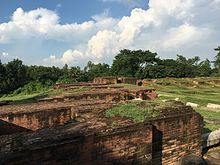Jagaddala Mahavihara
Jagaddala Mahavihara (also: Jaggadala ; Bengali জগদ্দল বিহার , fl. Late 11th century - mid-12th century) was a Buddhist clone and a teaching institution in Varendra , in what is now northern Bengal in Bangladesh . The monastery was owned by the later kings of the Pāla dynasty , possibly by Ramapala (~ 1077–1120). The monastery was probably founded at a location near the present-day village of Jagdal in Dhamoirhat Upazila in northwestern Bangladesh , on the border with India ( Paharapur ).
location
Little is known about Jagaddala compared to other Mahaviharas of the same era. For a long time the location could not be determined with certainty. AKM Zakaria examined five possible locations, all of which had the designation Jagdal or Jagadal in common. All were in the Rajshahi - Malda region: Panchagarh ; Haripur Upazila in Thakurgaon ; Bochaganj Upazila in Dinajpur ; Dhamoirhat Upazila in Naogaon and the Bamangola block of Malda , India. Significant ruins can only be found in Jagdal in Naogaon. Excavations under the direction of UNESCO in the last few decades have shown that the ruins belonged to a former Buddhist monastery.
history
founding
During the Pala rule in northeast India, numerous monasteries or vihara were founded in the area of ancient Bengal and Magadha (756–1174 AD). It is said that Dharmapala (781-821) alone founded 50 viharas, including Vikramashila , the very first university in the area. Jaggadala was founded at the end of the Pāla Dynasty, probably by Rāmapāla (~ 1077-1120). According to Tibetan sources, there were five outstanding Mahaviharas: Vikramashila ; Nalanda , Somapura , Odantapurā and Jagaddala. The five monasteries formed a network; "All were under state supervision" and there was a "system of coordination between them ... it appears that the various seats of Buddhist scholarship in eastern India were viewed among the Pāla as a network, and as an interconnected group of institutions" . It was often the case that the great scholars could easily move from one position to another in the different schools.
Jagaddala specialized in Vajrayana studies . Many of the texts that were produced there found their way into the Tibetan Buddhist canons Kanjur and Tanjur . It is likely that the earliest anthologies of Sanskrit poetry, the Subhāṣitaratnakoṣa, were compiled by Vidyākara in Jaggadala.
Decay
Śakyaśrībhadra , a scholar from Kashmir , the last abbot of Nalanda Mahavihara and an important communicator for Buddhism to Tibet, is said to have fled Tibet to Jagaddala in 1204 when Muslim conquest threatened. The historian Sukumar Dutt suspects the ultimate destruction of Jagadala around 1207; apparently it was the last vihara that was destroyed.
Excavations and UNESCO status
In 1999 Jaggadala was put on the tentative list for inclusion in the UNESCO World Heritage . UNESCO reports that excavations have revealed “a vast hill, 105 m by 85 m long, which represents the archaeological remains of a Buddhist monastery ... Finds include terracotta slabs, decorative bricks, nails, a gold clasp and three stone images of Gods ”.
gallery
gallery
Individual evidence
- ^ A b Sukumar Dutt: Buddhist Monks And Monasteries Of India: Their History And Contribution To Indian Culture. George Allen and Unwin Ltd, London 1962: 377.
- ↑ a b UNESCO World Heritage Site.
- ↑ a b http://en.banglapedia.org/index.php?title=Jagaddala_Mahavihara
- ↑ Elizabeth Deutsch: Vajrayoginī: Her Visualizations, Rituals & Forms . Wisdom Publications: 15. ISBN 9780861713295
- ↑ Sukumar Dutt: Buddhist Monks And Monasteries Of India: Their History And Contribution To Indian Culture. George Allen and Unwin Ltd, London 1962: 352-353. ISBN 9788120804982 "all of them were under state supervision" ... "system of co-ordination among them ... it seems from the evidence that the different seats of Buddhist learning that functioned in eastern India under the Pāla were regarded together as forming a network, an interlinked group of institutions "
- ↑ Sukumar Dutt: Buddhist Monks And Monasteries Of India: Their History And Contribution To Indian Culture. George Allen and Unwin Ltd, London 1962: 378. ISBN 9788120804982
- ^ Kurtis R. Schaeffer: Dreaming the Great Brahmin: Tibetan traditions of the Buddhist poet-saint Saraha. Sarahapada: 88.
- ↑ Sukumar Dutt: Buddhist Monks And Monasteries Of India: Their History And Contribution To Indian Culture. George Allen and Unwin Ltd, London 1962: 379-80. ISBN 9788120804982
Coordinates: 25 ° 9 ′ 32 ″ N , 88 ° 53 ′ 15 ″ E



